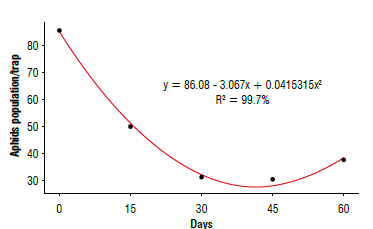Introduction
Chrysanthemum, Chrysanthemum morifolium Ramat., stands out as one of the main ornamental species in the world with great relevance in the cut flowers and potted plants market (Bhargavi et al., 2018). It is a common plant in the northern hemisphere, mainly Asia and Europe, and is one of the main flower species commercialized in countries like India, Colombia, and Brazil (Dhiman et al., 2018; Zandonadi et al., 2018; Parrado-Moreno et al., 2019; Sreedhar et al., 2020).
In Brazil, commercial floriculture has greatly expanded and become more competitive in recent years, proving to be a very promising commercial sector (Souza et al., 2020). Currently, the ornamental chain in the country has 8,000 producers of flowers and plants that together produce more than 2,500 species, including the chrysanthemum, which is among the main species cultivated for cut flowers and potted plants (Instituto Brasileiro de Floricultura, 2021).
Ease of cultivation, high return, great beauty and durability of inflorescences and especially great diversity are characteristics that contribute to the great worldwide popularity of chrysanthemums and make them suitable for various purposes, including interior and exterior decorations of houses, use in exhibitions, and production of garlands and bouquets (Heidemann & Barbosa, 2017; Dhiman et al., 2018; Thakur et al., 2018). However, the crop is affected by several factors, especially pest attacks, such as aphids, caterpillars, mites, white flies, and thrips (Saicharan et al., 2019).
Aphids are considered the most common pests that infest the crop with several species recorded such as Macrosiphon-iella sanborni Gillette, Myzus persicae Sulzer, Acyrthosiphon pisum Harris, and Aphis gossypii Glover (Ali, 2017). These are small, sap-sucking insects that affect several plant species and can cause a wide range of damage, including weakening and yellowing, sprout deformation, honeydew secretion and consequent fungal development, and virus transmission that cause diseases (Singh & Singh, 2016).
Biotic factors, such as natural enemies and interspecific and intraspecific interactions, and abiotic factors, such as climatic conditions, presence of insecticides, and use of anti-insect and photoselective screens affect population dynamics and insect behavior (Nyamukondiwa et al., 2013).
Photoselective screens are tools that are being increasingly used in agricultural and ornamental crops. These screens function as a physical barrier for pests and act by modifying the spectrum and scattering light, a condition that directly influences pest behavior (Shahak et al., 2008). In addition, photoselective screens also impact the morphology and physiology of plants, promoting beneficial actions in the development and productivity of crops (Abbasnia et al., 2019; Bastías et al, 2021).
Researchers around the world have evaluated the influence of photoselective screens on populations of various pest species (Ngelenzi et al., 2019; Candian et al., 2020). However, in Brazil, studies with photoselective screens are focused on their impact on plants (Almeida et al., 2021; Sales et al., 2021). There is a gap in relation to the influence of these screens on agricultural pests in the conditions found in Brazil.
In this context, it is urgent to understand the impact of using photo-selective screens on pest populations and to assess their potential for use in ornamental crops under environmental conditions in Brazil. The objective of this study was to evaluate the influence of photoselective screens on the population density of aphids in the cut chrysanthemum variety Zembla.
Materials and methods
The study was carried out in the experimental area of the Federal Institute of Espírito Santo - Campus Itapina, located in the district of Itapina in Colatina - ES (Brazil). The region has a tropical climate according to the Kõppen classification, characterized by seasonal rainfall and high temperatures (Köppen, 1936; Peel et al., 2007). The soil of the experimental area is classified as Dystrophic Red-Yellow Latosol (Santos et al., 2018).
Before installing the experiment, two simple samples were collected at a depth of 0 to 20 cm from each bed with a probe-type auger. The samples were homogenized in a clean container to form a composite sample, from which a sample was taken for chemical analysis at the Laboratory of Soil Analysis of IFES - Campus Itapina. This information was used to make fertilization recommendations for the cultivation of the variety Zembla chrysanthemum (white). The variety of chrysanthemum Zembla (white), acquired from the company Terra Viva located in the municipality of Holambra, São Paulo, was used in the experiment.
The experiment was conducted during the winter, between the months of July and September 2019 (July 24 to September 24). Maximum and minimum air temperature and relative air humidity were obtained from an automatic station of the National Institute of Meteorology (INMET), located in Marilândia - ES, 45 km away from the study (Fig. 1).
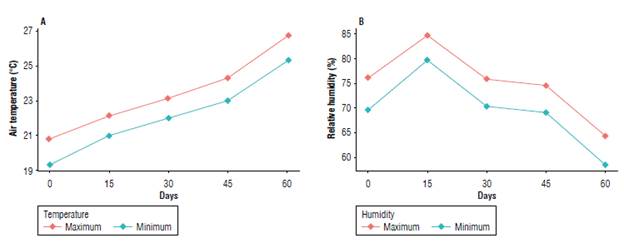
FIGURE 1 Maximum and minimum air temperature and relative air humidity during the experimental period (July 24 to September 24, 2019). INMET automatic station, Marilândia - ES (Brazil), 2019.
The experiment was conducted in a randomized block design, according to a split-plot scheme over time. The primary factor (plots) consisted of 4 different cropping systems: red, silver, and black photoselective shading screens and field conditions (control); and the secondary factor consisted of repeated evaluations over time (0, 15, 30, 45, and 60 d).
We established 3 blocks that consisted of beds 12 m long by 1.20 m wide and 7 planting lines covered by a 2.10 m high cultivation tunnel (except for the areas related to the control treatment). These were established with a rotating hoe. The plots referring to the different treatments were 3 m long and consisted of 28 plants with a spacing of 15 x 15 cm between them. During the vegetative period, luminous supplementation was performed, supplied by 25 W lamps for 4 h until the plants reached a commercial stem height of 70 cm. Plants were irrigated using a micro sprinkler system. All screens used offered 35% shading.
The infestation of aphids on chrysanthemum plants was natural. To monitor the incidence and population density of this pest, one yellow checkered adhesive trap (10 x 19.5 cm) was used per plot, placed at a height of 10 cm from the plants. Each plot of the block received a trap distributed equidistantly and the evaluations for counting the aphids were carried out every two weeks.
Data were checked for normality and homoscedasticity and submitted to the Tukey's test (P<0.05) to compare treatment means. As for the time factor, the non-parametric method of smoothing a scatterplot with local weight (LOESS regression) was applied that estimates curves and surfaces through reference-free smoothing of an explicit mathematical model.
The data violated the assumption of normality and homogeneity of variance; and it was necessary to apply a logarithmic transformation (in base 10), mainly to stabilize the variance between treatments. Due to the fact that the data contains a lot of zeros, the formulation z=log (x + 1) was used, where x represents the original data and z the transformed values. After processing the analyses, the data were returned to the original scale.
Results and discussion
From the analysis of variance, there was no significant interaction between the crop systems under photoselective screens and the evaluation period for the population density of chrysanthemum aphids. For this reason, the factors were analyzed independently (Figs. 2-3).
For the different cropping systems under photoselective screens (F=13.11, P<0.01), the results of the Tukey test at the 5% significance level showed that the mean incidence of aphids in the control or field treatment (47.3) differed statistically from the mean values of the other treatments. The data were as follow: 10.7 (black color screen), 7.27 (red color screen) and 5.4 (silver color screen) (Fig. 2).
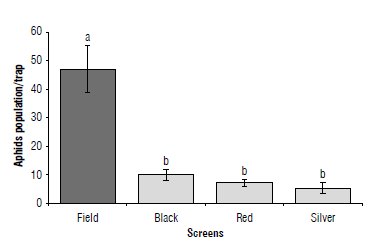
FIGURE 2 Effects of photoselective screens on aphid populations in a crop of Chrysanthemum moritolium variety Zembla. IFES, Colatina-ES (Brazil), 2019. Means followed by the same letter do not differ from each other by the Tukey test at 5% significance. Bars represent the standard error. Results obtained from the transformation of data into Iog10 and are presented in its original form.
Therefore, regardless of the color of the screen used, the cultivation of chrysanthemum under photoselective screens promoted a lower incidence of aphids compared to the open field treatment.
The adoption of cultivation techniques aimed at protecting plants and soil has been widely used in agriculture to improve production, yield, and product quality (Shahak, 2014). Photoselective screens or nets have been employed with the aim of protecting plants from adverse conditions such as excessive solar radiation, drought, wind and hail, in addition to their use in protecting against insect attack (Shahak et al, 2008; Silva et al, 2013; Shahak, 2014).
Although photoselective screens have holes large enough for pests such as aphids, thrips, and whiteflies to pass freely, several studies have demonstrated different responses of these insects to these screens (Shahak et al, 2004; Ben-Yakir etal, 2008; Shahak, 2014).
Chromatic additives and dispersive and reflective elements added to the composition of photoselective screens allow them to act as spectral modifiers and light disperses (Shahak et al, 2008). The fraction of light that passes through the screen holes remains unchanged in terms of its quality, while the light that reaches the wires has its spectrum modified and dispersed (Shahak et al, 2004).
Red photoselective screens absorb light in ultraviolet, blue, and green wavelengths of solar radiation and enrich the red and far-red spectral region. Gray screens absorb ultra violet, blue, green, yellow, far red, and infrared radiation and are not good light dispersants, while black ones only act on the amount of light, not altering its quality (Shahak, 2008).
They act as a mechanical barrier for insects as a plastic structure that is placed around the plants, preventing them from reaching the crops and consequently causing direct damage and virus transmission. They also act on the behavior of the aphids, since the perception of ultraviolet light is fundamental for insects for initial flight stimulation, in the location of hosts, in the dispersion within the cultures and in the orientation during the flight, all modified by the photoselective screens (Kigathi & Poehling, 2012). However, as highlighted previously, black screens do not modify the quality of light; and their action is limited to a physical barrier, a condition that may be associated with a higher incidence of aphids in them, although it does not differ statistically from the others (Fig. 2).
Insect vision is promoted by the presence of photoreceptors present in their ocelli and compound eyes. These have ocular photoreceptors capable of recognizing the spectrum of electromagnetic energy in the bandwidth of the ultraviolet (200-400 nm), visible or photosynthetically active radiation (400-700 nm), and far red light (700-800 nm). However, for spectral discrimination to occur, a minimum of two types of photoreceptors located in different parts of compound eyes is necessary (Diaz & Fereres, 2007). Thus, when artificial modifications are made to UV photons, as in the case of photoselective screens, the recognition of the host plant by herbivorous insects is compromised; and, consequently, there is a change in its orientation (Gulidov & Poehling, 2013).
Modifications in pest populational dynamics by using photoselective screens agree with results obtained by Ngelenzi et al (2019) who observed reductions in aphid and whitefly populations in bean (Phaseolus vulgaris L.) plants grown under photoselective screens compared to open field treatment. Similarly, Candian et al. (2020) obtain significant reductions in the populations of Halyomorpha halys Stal and Drosophila suzukii Matsumura in apple plants (Malus domestica Borkh.) cultivated under photoselective screens.
As for the different epochs, the analysis of variance did not show a significant difference between the averages of aphid incidence in the period evaluated (F= 0.8798, P=0.48) (Fig. 3).
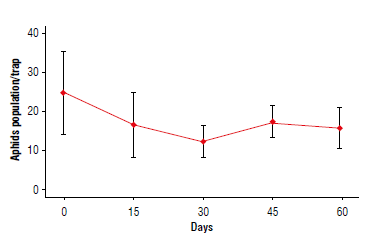
FIGURE 3 Populational fluctuation of aphids in Chrysanthemum morifo-lium variety Zembla cultivated between the months of July and September, 2019. IFES, Colatina-ES (Brazil). Bars represent the standard error. Results were obtained from the transformation of data into Iog10 and presented in its original form.
The local regression method (LOESS) was used to adjust the data considering the variation between epochs within the different levels of the crop system. It is possible to notice that the photoselective screens showed practically the same behavior around a constant value with mild oscillations where both curves remained within the confidence limits (Fig. 4). However, the effect of different epochs in the control level (field) stood out; the data showed a well-defined non-linear trend. So, it was possible to establish a cubic polynomial model with an R2=99.7% (Fig. 5).
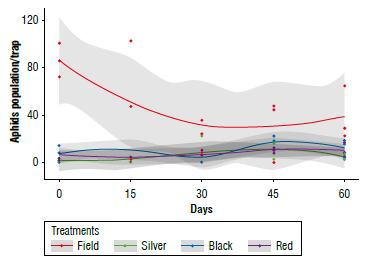
FIGURE 4 Overview of LOESS regression analysis across all treatments, disregarding screen effects over time (d). IFES, Colatina-ES (Brazil), 2019.













